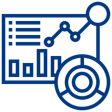
Data Modelling & Integration is crucial for businesses that rely on multiple systems and data sources, as it enables seamless data exchange, consolidation, and synchronisation. It ensures data integrity, consistency, and accessibility, facilitating effective decision-making and improving operational efficiency.

Data Modelling & Integration ensures consistent data definitions, formats, and standards across different systems and databases. It reduces data duplication, inconsistencies, and errors, enhancing the accuracy and reliability of information.

By integrating disparate systems and data sources, Data Modelling & Integration enables smooth data flow and exchange between applications and databases.

Integrated data models provide a unified view of business information, enabling stakeholders to make informed decisions based on accurate and up-to-date data. It enhances data analysis, reporting, and visualisation, empowering decision-makers to identify trends, patterns, and insights.

Efficient data integration streamlines business processes by automating data transfers, synchronisation, and updates. This reduces manual effort, minimises data processing time, and improves overall operational efficiency.

Data Modelling & Integration solutions are designed to accommodate changing business needs and evolving data requirements. They can scale to handle increasing data volumes, adapt to new data sources, and support future growth and expansion.

Data Modelling & Integration ensures data quality by implementing data validation rules, cleansing techniques, and error handling mechanisms. It supports data governance practices, such as data lineage, data security, and data privacy, ensuring compliance with regulatory requirements.

Integrated data models facilitate data sharing and collaboration across departments and teams. It enables real-time access to relevant data, promotes cross-functional collaboration, and improves communication and alignment across the organisation.

Data Modelling & Integration eliminates the need for manual data entry, data reconciliation, and data migration efforts. It reduces data-related errors and associated costs, improves data accuracy, and optimises resource utilisation.

Data Modelling & Integration solutions lay the foundation for a robust and future-proof data architecture. It supports the integration of emerging technologies, such as cloud services, IoT devices, and artificial intelligence, enabling businesses to leverage the full potential of their data.
By implementing effective data modelling and integration solutions, businesses can optimise data management processes, drive better insights, and gain a competitive edge in the data-driven era. Contact us to find out how we can support you.

Business Plan Reporting Solution
We were engaged to design and build a digital business planning & reporting solution that steps Local Land Services staff through the planning process, aligning to both state and regional strategies.
Choose Accelerate and experience a more efficient, faster, and cost-effective way to achieve your business goals.
© 2023 Accelerate Tech Pty Ltd. All rights reserved.